Planning to visit Modena? What a brilliant idea, it’s definitely one of the coolest towns in Emilia-Romagna, with great places to eat, to go shopping, and even a UNESCO-heritage site. Not to mention, it’s my Mum’s hometown!
Experience the best of Modena on these tours! Our favourite tour provider is GetYourGuide, offering a variety of activities, flexible booking, and 24/7 support!
- Maranello and Modena: Ferrari Museums Combo Tickets – Modena is the home of Ferrari, make sure you book in advance tickets to the TWO FERRARI MUSEUMS!
- Modena: 2-Hour Private Walking Tour – including Duomo, Ghirlandina, and other sights in the centre!
- Modena Food Walking Tour with Lunch – taste traditional products, followed by a sit-down lunch
- Modena: Traditional Balsamic Vinegar DOP Lunch – learn all about Modena’s most famous export
- Modena Market Tour and Cooking Class – for real foodies!
Is Modena worth visiting? If you’ve decided to add Emilia-Romagna to your Italy itinerary, this question probably will have crossed your mind. I’m sure you’ll be visiting Bologna – but what about Modena?
Well, my mother is from Modena and I have visited countless times throughout my life, so I may be a bit biased – but if you ask me, yes, Modena is worth visiting. Food is certainly a great reason, as Modena has some truly incredible restaurants – La Francescana by celebrity chef Massimo Bottura may be the most famous, but there are also plenty more.
There are also great shops, a wonderful market, and did I mention Modena is also the hometown of Ferrari? There are two Ferrari museums, and even the opportunity to drive your own Ferrari on a race track.
Last but not least, Modena is just a really nice place to be. You may be familiar with the city’s lifestyle if you watched Master of None. Yes, that was a TV show so everything was a little exaggerated, but Modena is indeed a pleasant place to spend some time, not yet overrun by mass tourism.
So, let’s have a look at the best things to do in Modena, followed by practical info to help you plan your trip!

Things to Do in Modena – History and Art
1) Duomo di Modena
The Duomo di Modena (Modena Cathedral) is a true masterpiece of Romanesque architecture – for this reason, in 1997 the Duomo was included in the UNESCO list of Italian World Heritage Sites. Its official name is the Cattedrale Metropolitana di Santa Maria Assunta e San Geminiano, but everyone knows it as the Duomo di Modena. Located in Corso Duomo, it is just a few steps away from Piazza Grande and the Ghirlandina bell tower, another Modena sight you cannot miss.
The design and construction of the Duomo are mainly attributed to two figures: architect Lanfranco, and a sculptor named Wiligelmo. Construction began in 1099, only to be completed in 1389 after the intervention of the Campionesi masters, a corporation of sculptors and builders from the Lake Como area.
The style used was Romanesque, popular throughout Europe from the 11th to 12th century, before the rise of Gothic art. Indeed, the Cathedral reflects precisely the characteristics of the Romanesque style, with a façade and roofs placed at different heights to create the shape of the inner naves. The external arches create a dynamic effect, while the doorway is protected by two stone lions.
The reliefs on the façade, created by Wiligelmo and placed on the side and central portals, depict the Stories of Genesis. Although nowadays the reliefs have a decorative function, they were created by Wiligelmo to tell the Genesis story to the people through images, as in the Middle Ages most of the common folk could not read.
The cathedral’s rose window and two side entrances were only added in the 13th century. The interior of the Cathedral has a three-aisle plan with a raised presbytery that serves as access to the crypt of San Geminiano. The spaces between the naves are separated by arches on pillars and columns.
2) The Ghirlandina
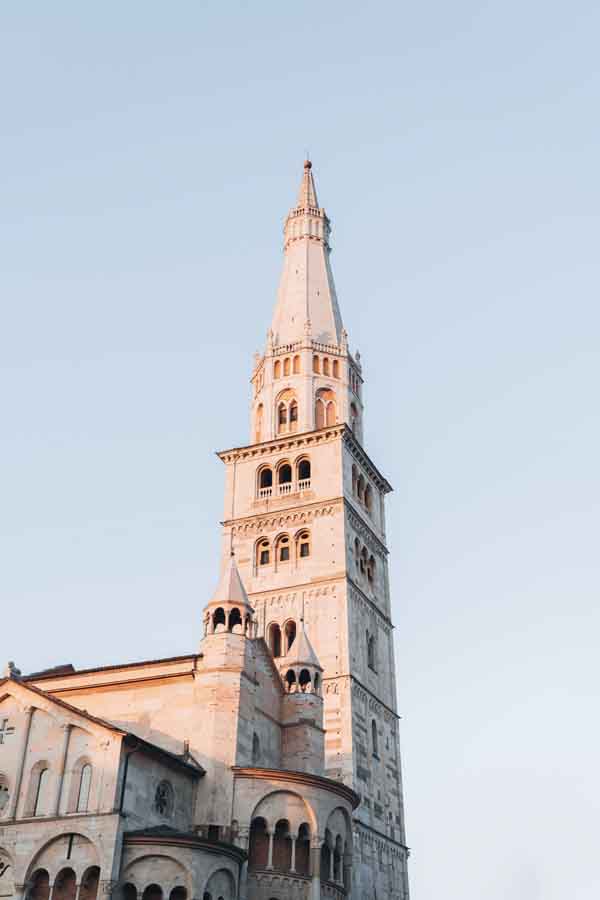
Together with the Duomo, the Ghirlandina is the symbol of Modena and a UNESCO heritage site. Located in Modena’s main square and about 90 metres high, the Ghirlandina owes its name to the marble balustrades which, according to the citizens, are ‘light as garlands’.
Originally, the Ghirlandina was the bell tower of the Duomo, from which the bells could signal an alarm to call the citizens inside the walls, or simply mark the passing of time. Like the Duomo, the Ghirlandina was built between the 11th and 13th centuries, combining architectural and sculptural knowledge.
Over the centuries, it has undergone numerous restorations, the latest in 2008, which served to repair some structural damages. You can still notice a distinct lean, not as bad as Pisa’s famous leaning tower, but still considerable at 1.60 from the centre. You can climb to the top of Ghirlandina, every day from Tuesday to Sunday, and the ticket is only €3.
3) Piazza Grande
Piazza Grande has been the crossroads of the city since its birth in the 12th century. Due to the presence of the cathedral, the square is also known as Piazza del Duomo. The view of the square overlooked by the Ghirlandina is truly spectacular.
In the past, the square was only used during market days, and it was also the place where criminals were executed and tortured. The presence of the Duomo obviously also made the square the main place for religious ceremonies and festivals, such as carnivals or the birth of a prince.
In the 20th and 21st century, the city of Modena (like the rest of Emilia-Romagna) enjoyed considerable economic growth, which led to the square becoming the perfect place for cultural events and artistic performances. Like the Duomo and the Ghirlandina, Piazza Grande has been a World Heritage Site since 1997.
4) Palazzo Ducale
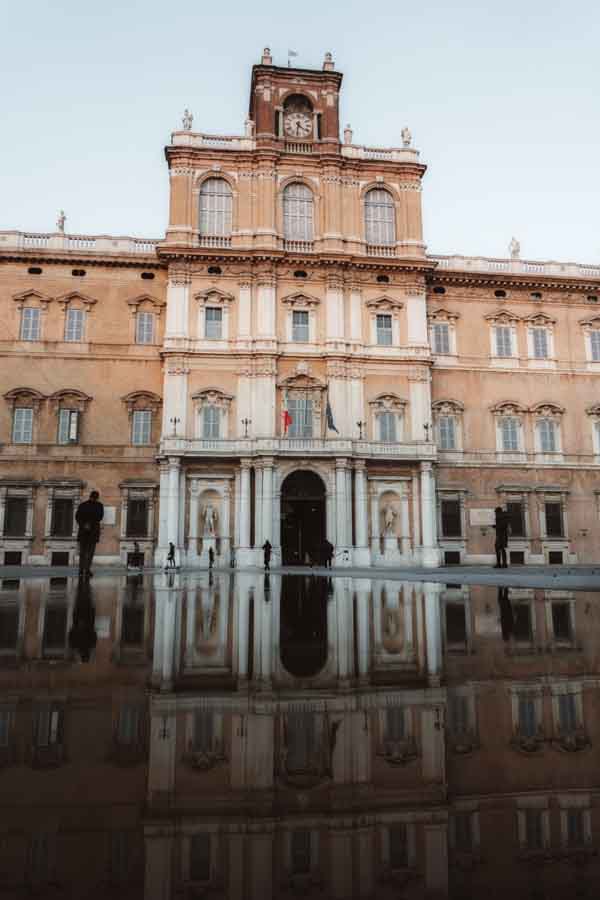
Together with the Duomo and the Ghirlandina, the third most important historical building in the city is undoubtedly the Palazzo Ducale. Built by Duke Francesco I d’Este in the 17th century, the palazzo was the residence of the Corte Estense until 1859. The Duke of Este had the palazzo built in place of an ancient medieval castle, also built by the d’Este family. The previous castle had the typical characteristics of a fortress, complete with a moat, but Francesco didn’t consider fit for a nobleman of his standing.
The result of the change was one of the most elegant palaces in all of Europe, with a façade with elegant windows with balustrades, decorated with statues. Inside is the Cortile d’Onore, spread over two floors, and considered a masterpiece of Baroque architecture.
As the Palazzo Ducale is currently home to the Military Academy, it is only possible to visit some of the rooms on a guided tour on Saturday and Sunday. Some of the spaces you can visit include the Scalone d’Onore, a monumental staircase with painted ceiling, and various rooms inside the Este’s former apartment, including the gilded Salottino d’Oro.
Would you like to explore another foodie city? Here’s our post about the 23 best things to do in Parma for some inspiration!
5) Galleria Estense
Located in Piazza Sant’Agostino and built at the end of the 19th century inside the Palazzo dei Musei, the often underestimated Galleria Estense is an important art gallery, with numerous artworks by ancient masters and collectors’ items.
The meticulously curated exhibition takes place in the elegant rooms of the palace, where you can admire paintings such as the Portrait of Francesco I d’Este by Velázquez, the Assumption of the Virgin by Ludovico Carracci and the Triptych by El Greco.
6) Casa Museo Pavarotti

Born in Modena in 1935, Luciano Pavarotti was one of the greatest tenors in history, famous for his talent, his personality, and his courage to bring opera into other genres of music with his Pavarotti & Friends project, through which he often organized fundraising concerts for the victims of war. Known as ‘Maestro’, Pavarotti left us in 2007, but he will never be forgotten.
The Casa Museo Luciano Pavarotti is located in the Modenese countryside, on an estate where the tenor spent the last years of his life. In 2015, the house was opened to the public, without being altered in any way. The house has a simple rustic style typical of the countryside, which reflects the tenor’s personality.
Inside, one can see photographs, paintings, and letters, as well as costumes, memorabilia and awards that give an insight into the tenor’s career. Similarly, in the house museum, there is furniture and objects representing everyday life, showing Pavarotti’s human side to the public.
Tickets for Casa Museo Luciano Pavarotti are limited – book one here or book this combo ticket also including entrance to the Ferrari Museum!
Things to Do in Modena – Motor Valley
7) Museo Enzo Ferrari (Modena)

The city of Modena and Ferrari are connected; after all, the founder of the famous automotive company was born in this city.
For this reason, a museum has been dedicated to the well-known entrepreneur, where you can learn more about his life, the history of Ferrari and, of course, his most famous cars. The museum is divided into two buildings: Enzo Ferrari’s house and his workshop, both of which can be visited, and where you can watch videos and listen to audio clips related to the history of Ferrari.
Make sure you get your ticket ahead of time as queues are really long! It is also possible to buy a combo ticket that includes a visit to the Enzo Ferrari Museum in Modena and the one in Maranello.
8) Museo Ferrari Maranello
Apart from the Enzo Ferrari Museum in Modena, if you are a motorsport fan, you really can’t miss the Ferrari Museum in Maranello, close to the Ferrari HQ.
The museum offers a collection of cars that made the history of the brand and its commercial success, as well as its great results in the world of motorsports. The museum is divided into four different areas, where you can admire Formula One cars, sport cars, prototypes and Gran Turismo cars. Inside the museum, you can also find a room dedicated to the cars and pilots that brought Ferrari on the top of the Formula One world, as well as a reproduction of the Enzo Ferrari original office.
True Ferrari lovers should consider booking this exclusive Ferrari Full-Day Tour, including both museums and the Ferrari Factory in Fiorano, plus lunch!
9) Fabbrica Maserati
Ferrari isn’t the only big supercar manufacturer to come from Modena – there’s also Maserati!
You can visit the Maserati Factory in the historical headquarters of the brand, where luxury cars have been produced for over 80 years. Visits include an introduction about the history of Maserati, followed tour of the factory floor, where you can see cars being assembled up close, including some recently-updated state-of-the-art equipment.
You’ll also learn about sustainability and innovation, and how supercar manufacturers are paving the way for a greener future for the motor industry (yes, I know, it sounds contradictory – read my post about our visit to the Lamborghini Factory and Museum to know more!)
Visiting the Maserati Factory may sound pricey at €50 per person, but it’s a rare chance to see up close how a supercar is born.
10) Collezione Umberto Panini
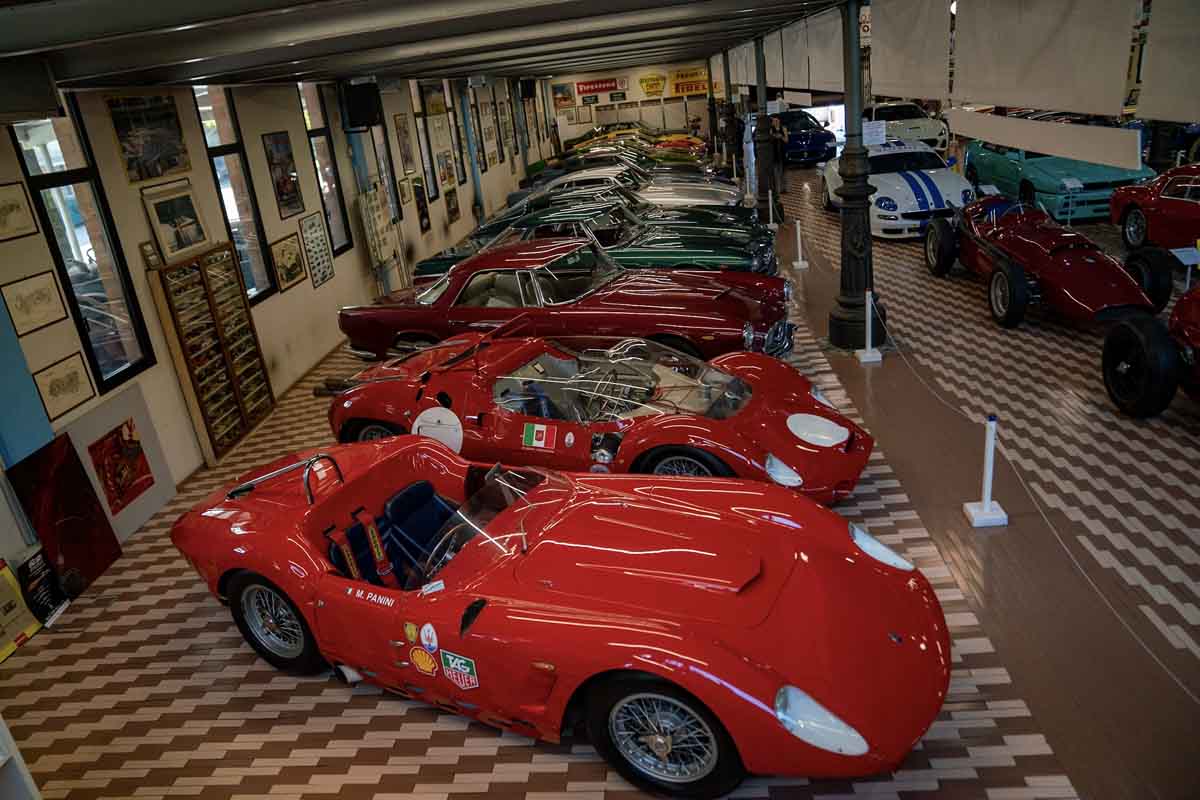
In Cittanova, in the Modenese countryside, you’ll find the Umberto Panini Collection, where you can admire several vintage cars that were once kept in the Maserati Museum.
The Panini family, known in Italy for the production of sticker albums (mainly featuring Italian football teams), has brought together several Maseratis over the years, so that the public can admire some of the most important ones, produced from the 1930s onwards.
In total, the exhibition includes 23 cars, including historic models that were protagonists and winners of important races such as the Mille Miglia and the Modena Grand Prix.
To make matters even better, the same compound also houses the Hombre Farm, producers of organic Parmigiano Reggiano. As far as I know, you can’t visit the factory, but you can buy some parmigiano reggiano to take home!
11) Drive a Ferrari around Modena Race Track

Ok, so after all this talk about supercars… would you like to drive one? If it sounds like something you might enjoy, you can book a Ferrari driving experience at the Modena Race Track, where you can choose from a variety of Ferrari available.
It’s also possible to have a professional driver take you around the track while you just enjoy the drive, which may be even better if you don’t have a license or are not a confident driver. Check this article about our Ferrari driving experience to know more.
Things to Do in Modena for Foodies
12) Mercato di Via Albinelli
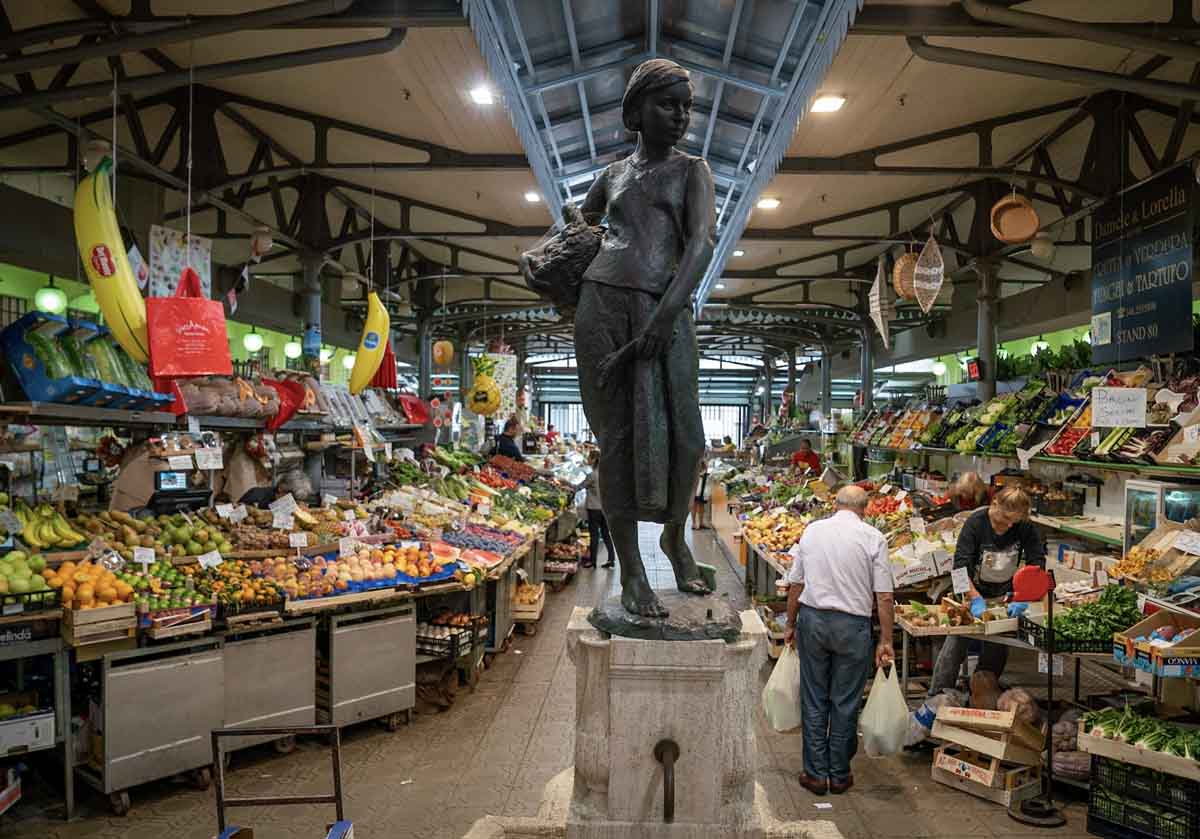
Strolling through the streets of Modena’s historic center is a real pleasure. The small size and architectural harmony of the arcades and historic buildings make it a relaxing and beautiful place to see. Among the most famous places in the centre, it is impossible not to mention the Albinelli Market. This is a covered ‘historic’ market dating back to 1931, characterised by an elegant Art Nouveau style.
At the centre of the market, you will find a fountain with a sculpture, surrounded by shops selling meat, charcuterie, cheese, fruit, vegetables, sweets, and bread. It is a place much loved by the people of Modena who visit it every day to buy top-quality products. Recently, a few stalls serving meals have opened up, allowing you to have lunch inside the market! We recommend Alvinelli, with delicious gourmet panini, and Artigiani del Gusto, perfect for an aperitivo with local wines, cheeses and salumi from around Modena.
I’ve been visiting the Mercato since I was a kid, and my favourite stand is Vanna e Roberto Formaggi, where we always buy Parmigiano and other delicious local cheeses. If you do go there, tell them Margherita says hi!
13) Visit Acetaia Pedroni
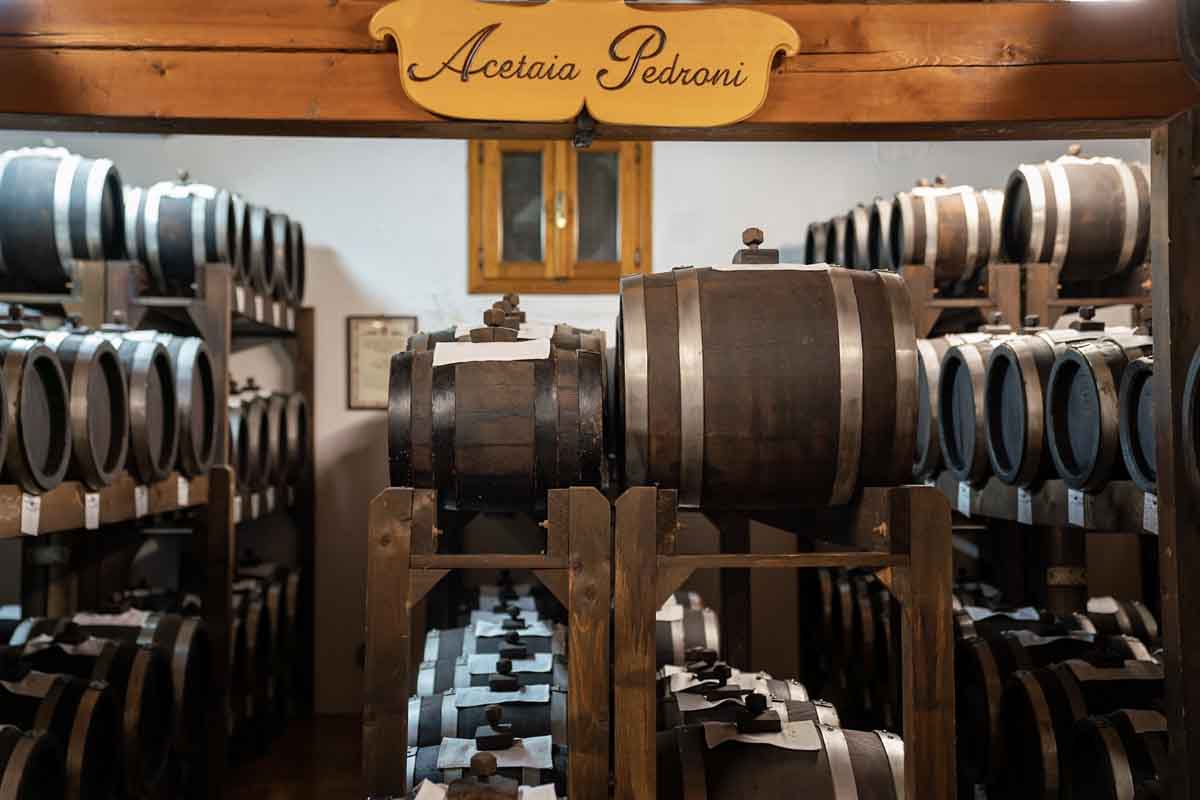
The gastronomic tradition of Emilia Romagna has become one of the main reasons for Italians and foreigners to visit. Parma has its parmesan cheese and prosciutto, Bologna its tortellini, while Modena is famous for its legendary traditional balsamic vinegar – you’ll notice it for sure at Mercato Albinelli and other food shops all over Modena.
Prepared according to a recipe handed down through generations, balsamic vinegar is made from cooked grape must, matured through a very long aging process. It is recognisable by its typical dark shiny smell and dense aroma, suitable for seasoning meat dishes, salads, and more.
Balsamic vinegar is produced by several vinegar works in the Modena area, such as the Acetaia Pedroni, founded in 1862 during the decline of the Estense Dukedom. If you are interested in discovering more about balsamic vinegar and perhaps purchasing a few bottles, you might consider visiting this Acetaia. There’s also an osteria on site, where you can try several recipes with the addition of balsamic vinegar!
14) Learn about Parmigiano Reggiano at Caseificio 4 Madonne
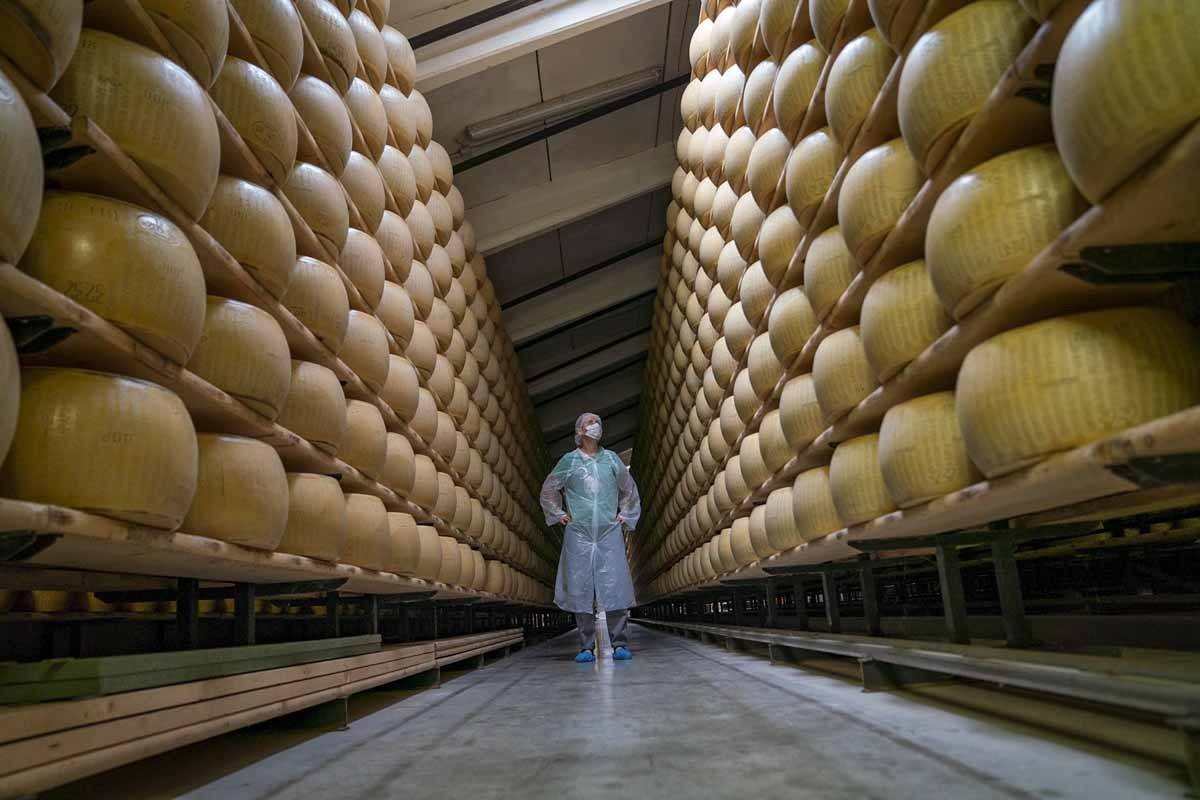
Another delicious product typical of Emilia-Romagna is Parmigiano Reggiano, produced in an area that includes the province of Modena.
We had the chance to visit a Parmigiano Reggiano factory during our trip to Fidenza and once again while we hiked the Via Francigena, and loved both of our visits that included a tour of the cheesemaking plant and of the maturation room, where all the wheels are kept to age.
Visiting a Parmigiano Reggiano factory can’t be missing from your list of things to do in Modena. The closest option to the city is Caseificio 4 Madonne, organizing hour-long tours in both Italian and English that include a final tasting. Just make sure you book your tour ahead – get in touch on Instagram for more info about schedule and costs.
Where to Eat in Modena
15) Osteria Francescana
Any article about where to eat in Modena can’t fail to mention Osteria Francescana, winner of several accolades including three Michelin stars and the 50 Best Restaurants award in 2016 and 2018.
Osteria Francescana is the flagship restaurant of celebrity chef Massimo Bottura, and if you have €325 to spare you can opt for a tasting menu with the inventive title of ‘I’m not there’, including a variety of Massimo’s classics like ‘Memories of a mortadella panino’, and ‘Oops! I dropped the lemon tart’, the dish featured on Chef’s Table.
I’ve never actually eaten at Osteria Francescana, but would love to one day. If your pockets aren’t quite deep enough, you can opt for Franceschetta 58, Bottura’s bistro.
16) Roots
Let’s continue our selection of where to eat in Modena with a truly unique place. Roots is a coworking space during the day, and an international restaurant at night, also doubling up as event space.
The restaurant employs migrant women during month-long traineeships, and the menu is inspired by these women’s home countries – so you may taste recipes from as far afield as Nigeria and Albania on the same night.
Roots supports female empowerment, and this can also be seen on their wine list, prioritizing labels from female-owned wineries.
17) Trattoria Ermes
Do you love local, no-frills eateries? Trattoria Ermes is a lunch-only restaurant in the centre of Modena, run for decades by its charismatic owner, Ermes, who sadly passed away in early 2023 at the age of 85.
Bruna now runs the kitchen, but the menu hasn’t changed – you’ll find traditional pasta dishes like tagliatelle al ragù, with the traditional Modenese version of the meat sauce with no tomatoes, and second courses like scaloppine (thin-cut veal) with Balsamico and meatballs with tomato sauce.
The price is about €25 per person and you might be sharing the table with other people, which just adds to the atmosphere of the place!
18) Lo Stallo del Pomodoro
Do you prefer something a little more upmarket, that is also open for dinner? Lo Stallo del Pomodoro is a restaurant housed in the former stables of a local noblewoman, lover of the Lord of Modena.
The menu includes traditional specialties made with locally-sourced ingredients with a creative touch – like horse tartare with hazelnuts and burrata, or a selection of charcuterie with homemade giardiniera. The wine list includes lots of natural wines.
Modena Practical Info
-Best Time to Visit Modena
Similarly to Bologna, Modena is a year-round destination, but every season has benefits and drawbacks. Summer is probably best avoided as it’s hot and humid, plus many businesses close for their holidays in August. Winter can be dark and rainy, but it’s the best time to enjoy local food, which can be quite heavy – not to mention, it’s low season and accommodation is at its most affordable.
Spring and autumn are the best times to visit Modena, especially the months of April/May and September/October. The weather is usually mild and sunny, and there’s still plenty of daylight. Modena is not (yet) overrun by tourists, so during these months crowds shouldn’t be a problem.
-Getting To Modena
-By Plane: The closest airport to Modena is Bologna (BLQ), about 45 minutes away by train and car.
-By Train: Modena is well connected to Italy’s Milan-Rome high-speed railway system. Not all high-speed trains stop in Modena, but you can get off in Bologna Centrale and connect to a regional train, taking only 30 minutes to reach the city. If you have time, you can also travel to and from Milan by regional train – travel time is about 2 hours each way.
As such, Modena can easily be visited as a day trip from Milan, Bologna or even Florence.
-By Car: If you’re on a road trip, you can reach Modena driving along the A1/Autostrada del Sole, the motorway crossing Italy from north to south. There are two motorway exits – Modena Nord and Modena Sud, depending on what direction you’re coming from.
A car will be useful if you’re planning to visit the surroundings of Modena, to see Acetaia Pedroni and Caseificio 4 Madonne for example.
-Getting Around Modena
With the exception of Acetaia Pedroni, Collezione Panini, and Caseificio 4 Madonne, you can easily reach all destinations mentioned in this article with a combination of walking and public buses.
Google Maps will give you info on bus stop location and what bus lines to take – a single ticket is €1.50, and contactless cards are accepted to pay your fare on the bus.
